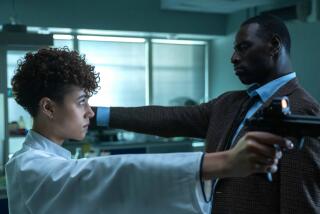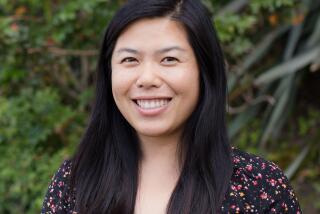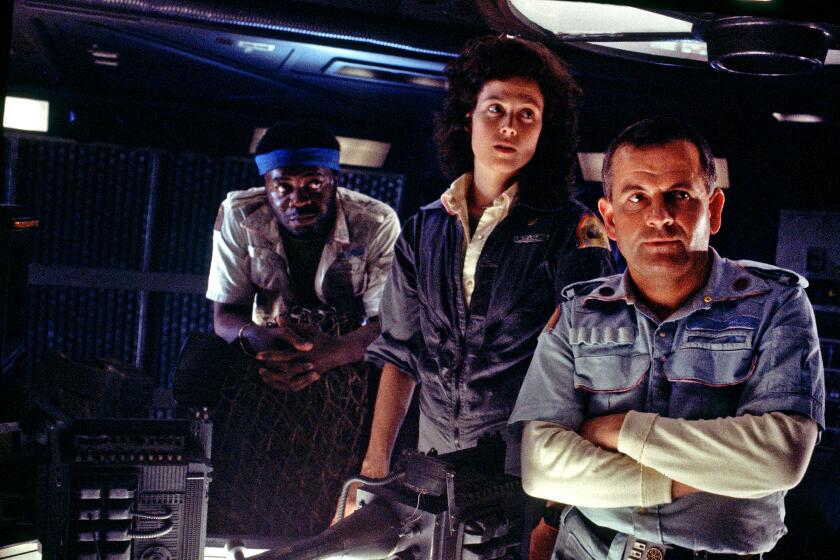Taiwanese director Hou Hsiao-hsien captures life’s big, small moments
At one point in the quietly wrenching “The Boys from Fengkuei,” a coming-of-age drama by the great Taiwanese director Hou Hsiao-hsien, the title characters are duped by a street hawker. They’re country kids trying their luck in the big city, and the huckster sells them tickets to what he promises will be a risqué “European double feature.” The hidden theater he sends them to, on an upper floor of a gutted high-rise, doesn’t exist, and there is no “big screen in color” — other than the view of sprawling Kaohsiung that awaits them, framed in perfect movie proportions by the building’s geometric shell.
The comic-dramatic moment, with its unexpected combination of self-reproach and wonder, is a bracing example of the cinematic language that has defined Hou’s work for 35 years. A master of mise-en-scène, he tells stories that might be considered plotless by Hollywood standards. But whole lives are revealed, along with the ever-charged roil of tradition and modernity, in the precise way he frames his characters’ experiences, his rigorous craft tapping fathomless wells of history and emotion.
Hou, who soon turns 68, is a key figure in Taiwan’s New Wave Cinema of the ‘80s and an international filmmaker whose influence runs deep and wide. Informed by unforced compassion and precision, his elliptical narratives are the opposite of spoon-fed entertainment. Among the contemporary art-house directors who have expressed their debt to him are Jim Jarmusch and Olivier Assayas.
He has collected laurels at the world’s leading festivals, and his long-in-the-works next film, “The Assassin,” has many fest watchers hoping it will be ready in time for Cannes this spring. Yet most of his pictures haven’t been released commercially in the U.S., leaving American moviegoers few opportunities to enjoy them on the big screen, where this consummate visual stylist’s work is best appreciated.
Angelenos will find a remedy for that beginning April 3, when a 2 1/2-month retrospective launches at UCLA Film & Television Archive’s Billy Wilder Theater and other venues. Organized by Bard College’s Richard I. Suchenski, “Also Like Life: The Films of Hou Hsiao-hsien” will unspool the virtuoso’s entire body of work.
From his early romantic comedies (a genre he has yet to revisit since 1982’s “Green, Green Grass of Home”) to the restrained autobiographical drama “A Time to Live and a Time to Die” and such period sagas as “The Puppetmaster,” “Good Men, Good Women” and “A City of Sadness” (the first Taiwanese film to win the Golden Lion at the Venice Film Festival), Hou’s range is striking. Though he’s sometimes misclassified as a minimalist because of his signature long takes and his frequent use of a fixed camera, his movies are bursting with life, however complicated or sad. The motifs he employs are powerfully expressive: trains, motorcycles, pool halls and the all-important communal table, in its endless permutations, appear throughout his cinematic landscape, at once lyrical and fraught with narrative intensity.
“Dust in the Wind,” the 1986 feature that opens the series, is a potent example of the way Hou’s artistry suffuses a simple, age-old story with texture and social detail. Like many of his films, it’s fueled by the dichotomy between country and city, illiterate and educated, old and young — in short, the never-ending tangle of past and present.
The movie’s central characters are childhood sweethearts who leave their rural hometown to work in Taipei. The departing boy’s father offers a mixed blessing: “If you want to be a cow,” he assures his son, “there will always be a plow for you.” When he sends him a waterproof Timex, purchased on installment, the cost worries the boy, whose decision to keep the timepiece in a glass of water is both irreverent and affectionate. By the time the young man leaves for the army, he and his girlfriend seem more like kids than at the story’s beginning, but their eyes are haunted by loneliness and fear; they’re dwarfed by the world.
Even when Hou isn’t directly addressing Taiwan’s political upheavals as a long-occupied territory, its social transformations register in his characters’ every glance and gesture. In “A City of Sadness,” widely considered a masterpiece, he chronicles the 1947 massacre of thousands of native Taiwanese by the Chinese Nationalists after Japan had relinquished its colonial rule. Compared with most of Hou’s films, the canvas of “City” has a larger historical sweep, but with a family as its prism, it maintains his preference for intimate storytelling.
Born in China and raised in Taiwan, where he arrived as an infant when his family fled civil war, Hou is alert to the clash and fusion of cultural forces within the island nation and from those specifics creates works of universal impact. At a remove from mainland studios, he often uses real locations, nonprofessional actors and improvisation, capturing something ephemeral in the process.
Though his films have been compared to those of the Italian neorealists as well as Yasujiro Ozu’s, his nods to Western art can be ambivalent. The overused classical score in the otherwise pitch-perfect “Boys From Fengkuei” might be a conflicted comment on Taiwan’s shifting horizons. But there’s undeniable alarm when his characters partake of Shakey’s Pizza (“Cheerful Wind”) or toil under the fluorescent lights of a Kentucky Fried Chicken (“Daughter of the Nile,” one of his less-celebrated and most achingly sad films).
In more recent years, Hou has ventured away from Taiwan for three movies. The first, 1998’s “Flowers of Shanghai,” is an elegantly composed and emotionally harrowing study of the hierarchy and mores of Shanghai’s 19th-century brothels. His frequent collaborator Mark Ping Bin Lee is responsible for the sumptuously austere cinematography, consisting entirely of long takes in interiors.
“Café Lumière,” commissioned for the centenary of Ozu, takes place in Tokyo, where trains arc through the city and people struggle to connect. In her first film performance, Japanese Taiwanese pop musician Yo Hitoto plays a writer researching a Taiwanese composer and caught between cultures. It’s a delicate exploration of solitude, intellectual pursuit and unspoken feelings.
In contrast, the Paris-set “Flight of the Red Balloon,” the first film Hou made outside Asia and an homage to Albert Lamorisse’s indelible 1956 short “The Red Balloon,” stars Juliette Binoche as a messily vibrant and aggrieved actress. Amid the domestic chaos she shares with her young son and a Chinese nanny, a blind piano tuner shows up, perhaps in a nod to the blind musician in Hou’s second feature, “Cheerful Wind” — a commercial romance saved from hokiness by the director’s restraint and the welcome focus on female independence.
That Binoche’s character does voice work in puppet theater is surely a reference to Hou’s “The Puppetmaster,” an exquisite hybrid of historical drama and the first-person testimony of puppeteer Li Tian-lu. Li experienced the Japanization of Taiwan firsthand when he was ordered to turn his art into propaganda. (The retrospective film program gets its title, Also Like Life, from the name of a troupe in the 1993 feature.)
The elderly Li also delivered memorable performances in “Dust in the Wind,” “Daughter of the Nile” and “City of Sadness” — liberated by age from day-to-day struggles, he’s usually the freest person in the story. Not only was Li, who died in 1998, a favorite of Hou’s, but, in a breakthrough for the Taiwanese movie industry, his distinctive dialect inspired the director to begin using synchronized sound rather than postproduction dubbing.
Another Hou favorite, Jack Kao, has appeared in six of his movies, among them the politically charged “Good Men, Good Women” and “Millennium Mambo,” which became the first of Hou’s films to receive commercial distribution stateside, more than two years after its Cannes premiere. In the Scorsesian “Goodbye South, Goodbye,” Kao’s small-time hood is a fascinating mix of hubris and sorrow.
On the surface a contemporary genre caper, the movie is one of Hou’s most thrillingly kinetic. When Kao’s character and his younger brother ride motorcycles on a country road, the sequence unfolds with an exuberance that makes it one of the most joyful in recent cinema — perhaps more so for the story’s undercurrent of dread. Elation devolves into a squabble over ancestral land, and by film’s end, tears have been shed and the brothers are searching for a key in the dark.
A melancholy ache courses through Hou’s filmography with timeless vitality. It’s no wonder that “A Summer at Grandpa’s,” a piercingly unsentimental portrait of the end of childhood, begins with a valedictory speech. The bittersweet pang may be heightened at summer’s end, but it’s always there. Cherishing his characters’ sadness as much as he does them, Hou doesn’t treat it as a problem to be solved.
“Café Lumière” star Hitoto recalled the filmmaker’s response when a barking dog disrupted a scene: Rather than trying to hush the animal, he accompanied it with his own barking. The incident stayed with her for reasons that she sums up beautifully: “I like that he loves everything the way it is.”
---------------------------------
When: April 3 through June 20
Where: Billy Wilder Theater, Westwood; REDCAT, downtown Los Angeles, American Cinematheque, Hollywood
Information: https://www.cinema.ucla.edu;(https://www.cinema.ucla.edu/events/2015/also-like-life-hou-hsiao-hsien)www.americancinematheque.com; https://www.redcat.org
More to Read
Only good movies
Get the Indie Focus newsletter, Mark Olsen's weekly guide to the world of cinema.
You may occasionally receive promotional content from the Los Angeles Times.










